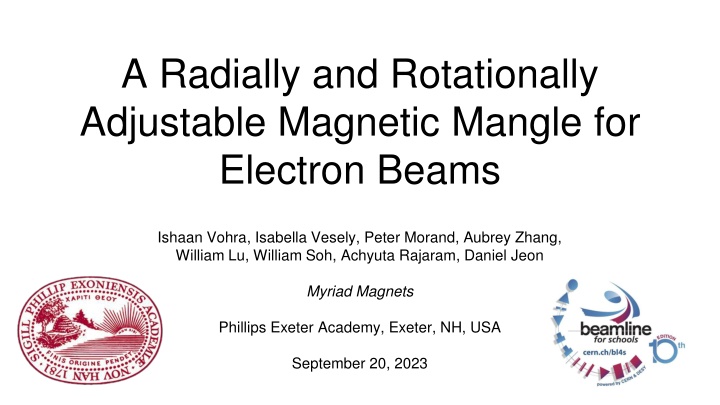A Radially and Rotationally Adjustable Magnetic Mangle for Electron Beams
The project introduces a radially and rotationally adjustable magnetic mangle designed by a diverse team from different locations. The motivation behind the experiment is to test the viability of an adjustable magnetic mangle as an alternative to traditional electromagnets in accelerators. The unique design allows for easy configuration changes, reduced energy consumption, and improved safety near other electronic devices. The team has conducted simulations to determine the optimal cylinder number for the mangle design and has iteratively improved the structure for safety and CERN experiments.
Download Presentation

Please find below an Image/Link to download the presentation.
The content on the website is provided AS IS for your information and personal use only. It may not be sold, licensed, or shared on other websites without obtaining consent from the author.If you encounter any issues during the download, it is possible that the publisher has removed the file from their server.
You are allowed to download the files provided on this website for personal or commercial use, subject to the condition that they are used lawfully. All files are the property of their respective owners.
The content on the website is provided AS IS for your information and personal use only. It may not be sold, licensed, or shared on other websites without obtaining consent from the author.
E N D
Presentation Transcript
A Radially and Rotationally Adjustable Magnetic Mangle for Electron Beams Ishaan Vohra, Isabella Vesely, Peter Morand, Aubrey Zhang, William Lu, William Soh, Achyuta Rajaram, Daniel Jeon Myriad Magnets Phillips Exeter Academy, Exeter, NH, USA September 20, 2023
The Team Achyuta Rajaram Hopedale, MA Ishaan Vohra (Team Lead) Sevenoaks, England Aubrey Zhang Vancouver, Canada William Lu Austin, TX Daniel Jeon New York, NY Peter Morand Simsbury, CT Isabella Vesely (Chief Engineer) Milwaukee, WI Will Soh Northbrook, IL
Experiment motivation Testing the viability of an adjustable magnetic mangle Halbach array as a proof of concept for electromagnet alternatives in accelerators Goals: Replace electromagnet energy usage as a contributor to climate change Safer to use near other electronics and pacemakers due to small external field Modular design: cost effective (compared to electromagnets), reduces waste
Magnet design: introduction A mangle of 8 permanently diametrically-magnetized cylinders arranged in a circle to produce either a dipole or quadrupole field Modularity: Rotating the magnets, the mangle can be switched: dipole configurations By moving the magnets radially inward or outward, the field strength can be adjusted quadrupole
Magnet design: determining optimal cylinder number Performed simulations in ANSYS Maxwell and quantified the deviation of the mangle s field from the corresponding ideal field using Relative Absolute Error (RAE)
Original Mangle Design - Goal: create on-the-fly radial and rotational adjustment of our magnet Updates: experiment handling safety, structural safety - Final Experiments at CERN: Update mangle with improved lock mechanism Explore stationary Halbach arrays - -
Many Design Iterations Final (stationary) Final (mangle)
Final Mangle Design - Goal: provide a proof of concept of a fully adjustable magnetic mangle - Magnets within casings, prevent involuntary translational/rotational movement - Rotation casings slide radially, octagonal pins - One casing has a mechanism to push, pull, and hold the full linkage in place:
Final Stationary Design - Goal: test the utility of Halbach arrays as alternatives to electromagnets, and study the effect of a changing radius - Two Halbach dipole arrangements, stronger magnets larger magnetic field - Already in beam area!
Thank you! Mr. DiCarlo Sarah Zoechling Markus Joos Martin Schwinzerl Berare Gokturk Margherita Boselli BL4S team and supporters!
Magnet design: determining optimal cylinder number As N, the number of magnets, increases, deviation from ideal magnetic field decreases, but for very large N rotating each magnet becomes impractical Performed simulations in ANSYS Maxwell and quantified the deviation of the mangle s field from the corresponding ideal field using RAE and are the mangle field and corresponding ideal field vectors at a given sample point i out of n total sample points.
Defining the corresponding ideal field For each set of cross-sectional mangle field with a given N, we define the corresponding ideal fields (centered at the origin) to be In the dipole case and In the quadrupole case. The magnitude of the ideal dipole s flux density, B, is obtained from the flux density at the array center. The ideal quadrupole s magnetic flux gradient, g, is obtained through a linear regression.























